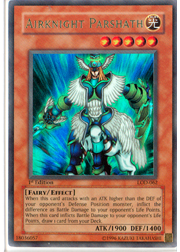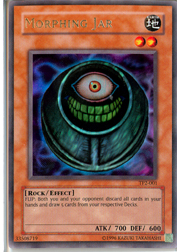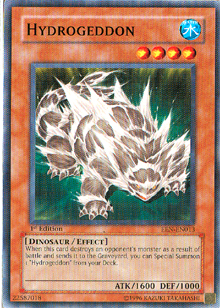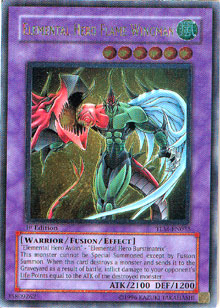At this time it would be too late to activate Kuriboh, because the damage has already been inflicted and can no longer be reduced to 0.

Example 1: Successful Direct Attack
Example 2: Robbin’ Zaloog
Randy has Don Zaloog in attack position and Robbin’ Goblin face up on his spell and trap card zone. His opponent Sherman has one card in his hand. Randy declares a direct attack with Don Zaloog. During damage calculation, Don Zaloog inflicts 1400 damage. Don Zaloog’s effect can now be activated and the effect of Robbin’ Goblin activates as well.
Randy knows that Robbin’ Goblin will discard the only card remaining in Sherman’s hand, so he decides to activate Don Zaloog’s second effect instead. Robbin’ Goblin and Don Zaloog are placed on the same chain.
Flipped Up and PO’ed
Now that we’ve completed damage calculation, the time has come to deal with the flip effect of the face-down monster that was attacked. Flip effects aren’t the only effects that use this event in the damage step. Some monsters have effects that activate at this time because they have been involved in battle. While most monsters with battle-based effects won’t do anything at this time, the "D.D." monsters most definitely will. Wall of Illusion and Kelbek use this event to activate their effects as well. Those pesky monsters with trigger effects that activate when they are flipped face up, like Nightmare Penguin, also activate at this time.
These chains are usually short, because the Yu-Gi-Oh! TCG doesn’t have a lot of effects that will do anything at this time. Normally this chain is limited to only the monsters that battled. It is rare to see another effect try to add itself to this chain, although monsters like Light and Darkness Dragon or the trap card Divine Wrath can be allowed. The placement of effects onto this chain will follow the rules of simultaneous effects, so the order will be based on who controls the effects.

Example 1: Airknight Vs. Face-Down
Airknight Parshath’s effect activates when the damage is successfully inflicted to Randy’s life points. Randy’s Morphing Jar activates afterward. Each effect is placed into two separate chains. The first chain belongs to Airknight Parshath, and after it resolves, the second chain for flip effects starts. Noah will draw a card with Airknight Parshath’s effect, but it will be discarded by Morphing Jar.
Example 2: D.D. Warrior Vs. the Wall
Monty has D.D. Warrior in attack position. His opponent Yesenia has Wall of Illusion in attack position. Monty attacks the Wall of Illusion with D.D. Warrior. Wall of Illusion is destroyed and Yesenia receives 200 points of damage.
After damage calculation, the effects of D.D. Warrior and Wall of Illusion start a chain. Monty is the turn player, so his effect is placed as chain link 1, followed by Yesenia’s Wall of Illusion as chain link 2. Wall of Illusion resolves first and returns D.D. Warrior to Monty’s hand. D.D. Warrior resolves next, removing Wall of Illusion from play.
Bon Voyage
After dealing with the flip effect event, if it was even needed, the monsters destroyed in battle must be sent to the graveyard. Monsters with effects that activate "when destroyed in battle" or "when destroyed in battle and sent to the graveyard" will activate at this time and start a chain. Monsters like Mystic Tomato, Giant Rat, Apprentice Magician, and Gigantes will activate their effects here. When Sangan is destroyed in battle, its effect will activate at this time. Monsters with effects that activate whenever they successfully destroy a monster in battle and send it to the graveyard will also activate at this time, like Hydrogeddon and Elemental Hero Flame Wingman.
Some spell and trap cards have effects that are involved in this process. Whether the effect will be added to the chain or be applied before/after the chain is entirely dependent upon the effect.
Macro Cosmos and
Dimensional Fissure apply when the monster is sent to the graveyard, removing it from play before it can even reach the graveyard.
Backfire will activate and start a chain when the destroyed Fire attribute monster is sent to the graveyard.
Skull Invitation will inflict damage when the destroyed monster is sent to the graveyard, but it will not start a chain.
Hero Signal and
Snake Whistle can be used to special summon a replacement monster.
 Example 1: Hydrogeddon Vs. Giant Rat
Example 1: Hydrogeddon Vs. Giant RatHal has
Hydrogeddon in face-up attack position. His opponent Scott has
Giant Rat in defense position. Hal uses
Hydrogeddon to attack
Giant Rat.
Giant Rat is destroyed. When it is sent to the graveyard, each player has an optional effect they can choose to activate. If both players decide to activate their effects,
Hydrogeddon is chain link 1 and
Giant Rat is chain link 2.
Example 2: Apprentice Magician Vs. Mystic TomatoWith equal ATK, both monsters are destroyed. When the time comes to send them to the graveyard,
Dimensional Fissure intends to remove them both from play instead. Reynaldo decides that he would rather "crystallize" the Cobalt Eagle, so it is placed into his spell and trap card zone.
Apprentice Magician is removed from play. However, this is not a problem for
Apprentice Magician, whose effect still activates because he only needs to be destroyed in battle. It doesn’t matter if he is sent to the graveyard or removed from play.
Some monsters have effects that should activate at this time, but when the monster is destroyed or otherwise removed from the field, its effect does not activate. The previously mentioned
Hydrogeddon is notorious for this.
Example 1: Hydrogeddon Vs. KelbekRodney has
Hydrogeddon in attack position. His opponent Samantha has
Kelbek in face-up attack position. Rodney declares an attack with
Hydrogeddon against
Kelbek.
Kelbek is destroyed and Samantha receives 100 points of damage.
After damage calculation,
Kelbek’s effect activates and returns
Hydrogeddon to Rodney’s hand. When
Kelbek is sent to the graveyard,
Hydrogeddon’s effect does not activate because it is not face up on the field.
End of the Damage Step
The end of the damage step event is home to very few effects. Sometimes these effects are dependent upon the survival of whichever monster intends to activate the effect and may not even activate if the source monster was destroyed. Monsters like Ryu Kokki, Chainsaw Insect, and The Six Samurai - Zanji apply their effects at this time.

Example: Elemental Vs. Zombie
When
Ryu Kokki is sent to the graveyard,
Elemental Hero Flame Wingman’s effect activates and inflicts 2400 damage to Chazz’s life points. Afterward,
Ryu Kokki’s effect destroys Flame Wingman.
Next week we will examine battle phase scenarios and apply what we have learned over the course of the month. Until then, send all comments and questions to Curtis@Metagame.com.